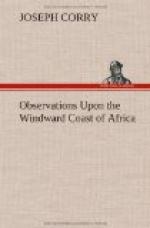These countries produce various hard woods, well adapted to cabinet work and ship building, and are singular in their qualites and properties.
The most remarkable are, 1st. the cevey, or kinney wood, which grows about the size of the oak, in England, and may be cut into planks of 20 feet by 15 inches. Its texture is something of the ash grey and mahogany, variegated with stripes, fancifully disposed, and is therefore adapted to cabinet work; its qualities for ship building are peculiar, having the virtue of resisting the worm and vermis, so destructive to shipping in tropical climates, and corroding iron; it grows in great abundance. Any quantity of this wood put into water sufficient to cover it, will, in a few hours, produce an unctuous substance floating on the top, resembling verdigrise, and of a poisonous quality.
Secondly, the dunjay wood, rather coarser in the grain, but harder in quality than the Spanish Bay mahogany. It possesses the same peculiarities as the cevey or kinney, in resisting the worm in salt water, and corroding iron. It may be procured in any quantity. And, Thirdly, the melley wood, or gris-gris tree, another species of mahogany, abundant in growth, having a more rare quality than the foregoing, resisting the worm in both salt and fresh water; it is extremely hard, and its juices so poisonous, in the premature state, as to cause instant death.
The manifold and neglected productions of this extraordinary continent require only to be developed, and when the useful arts of Europe are introduced here, ample recompense will attend the benevolent undertaking, natural history will be much enlarged, and mankind be greatly benefited. The claims of humanity, the distinguished part it has taken in an unnatural and much to be deplored commerce, loudly unite with a wise policy, in one impressive appeal to the feelings of the more refined inhabitants of Europe, and to none more than those of Englishmen.
The goods adapted to African commerce are,
East India goods—consisting of bafts, byrampauats, chilloes, romals, neganipauts, niccanees, red and blue chintz, Guinea stuffs, bandanoes, sastracundies, &c.
Manchester goods.—Cotton chilloes, cushtaes, neganipauts, photaes, romal handkerchiefs, silk handkerchiefs, &c. Linen Britanias, slops, spirits, tobacco, guns, swords, trade chests, cases, jars, powder, umbrellas, boats, canvas, cordage, pitch, tar, paints, oil, and brushes, empty kegs, kettles, pans, lead basons, earthenware, hardware, beads, coral, iron bars, lead bars, common caps, Kilmarnock ditto, flints, pipes, leg and hand manilloes, snuff boxes, tobacco boxes, cargo hats, fine ditto, hair trunks, knives, looking glasses, scarlet cloth, locks, shot, glass ware, stone ware, provisions, bottled ale and porter, &c. &c.
The foregoing general enumeration may serve to convey a just conception of the various manufactures requisite in the African trade, and the different branches to which it is allied, yeilding support to a numerous body of merchants, manufacturers, artizans, and many of the labouring class of the community.




